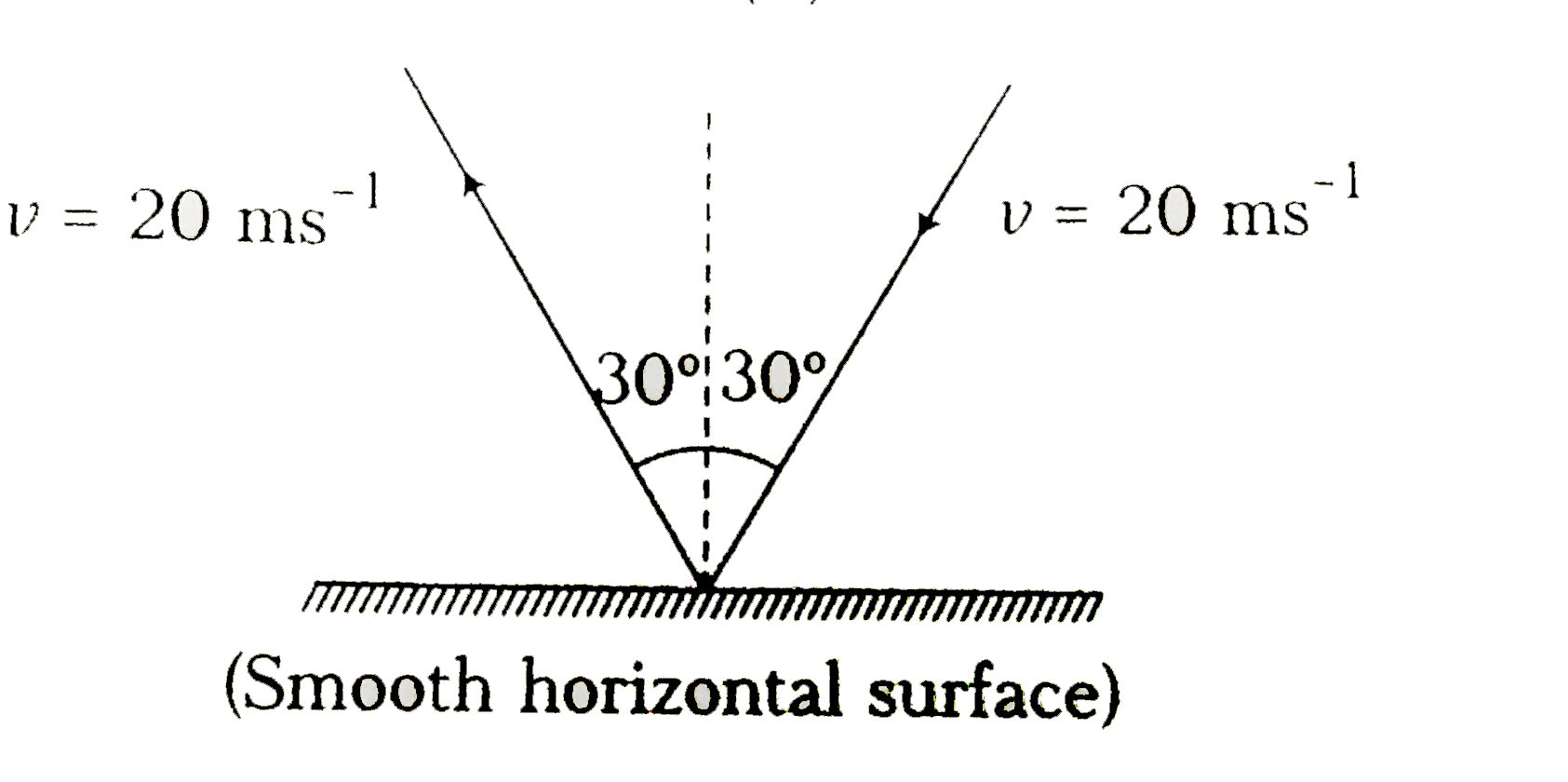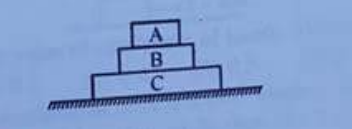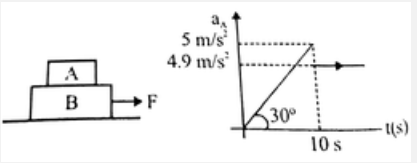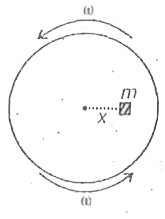Complete Solutions to EXERCISE of chapter LAWS OF MOTION of Class 12 book with complete answers and questions
| Class 12 | PHYSICS |
| Chapter | LAWS OF MOTION |
| AAKASH INSTITUTE | EXERCISE |
| Number Of Questions | 69 |
| Academic Year | 2023-24 |
The concept of inertia is explained in :-
View SolutionInertia of a body has direct dependence on
View SolutionAccording to Newton's 2nd law of motion correct equation is (where symbols have their usual meanings)
View SolutionA body of mass 6 kg is acted on a by a force so that its velocity changes from `3 ms^(-1)` to `5ms^(-1)`, then change in momentum is
View SolutionThe momentum p (in kg `ms^(-1)`) of a particle is varying with time t (in second) as `p=2+3 t^(2)`. The force acting on the particle at `t=3s` will be
View SolutionA body is acted upon by balanced forces
View SolutionImpulse on a body is equal to
View SolutionA bull of mass m is moving towards a player with velocity v. If player stopped it, then impulse applied by the player is
View SolutionA body of mass m is projected with intial speed u at an angle `theta` with the horizontal. The change in momentum of body after time t is :-
View SolutionThe working of rocket is based on the principle of ________________.
View SolutionA ball is moving with speed `20 ms^(-2)` collides with a smooth surface as shown in figure. The magnitude of change in velocity of the ball will be

View SolutionIf impulse I varies time t as I`(kg ms^(-1))=20t^(2)-40t`.
The change in momentum is minimum at :-
View SolutionA machine gun fires n bullets per second and the mass of each bullet is m. If v is the speed of each bullet, then the force exerted on the machine gun is
View SolutionAn initially stationary device lying on a frictionless floor explodes into two pieces and slides across the floor one piece is moving in positive x direction then other peice is moving in
View SolutionIf final momentum is equal to initial momentum of the system then
View SolutionA ball is moving towards the wall as shown in diagram then momentum is conserved

View SolutionA body of mass 5 kg is moving with velocity of `v=(2hati+6hatj)ms^(-1)` at t=0s. After time t=2s, velocity of body is `(10 hati+6 hatj)`, then change in momentum to body is
View SolutionA cart loaded with sand moving with velocity v. Sand is falling through the hole as shown in diagram then after falling on the ground sand is

View SolutionA particle of mass m strikes elastically on a wall with velocity v, at an angle of `60^(@)` from the wall then magnitude of change in momentum of ball along the wall is
View SolutionThe average force necessary to stop a hammer with momentum p (in N-s) in 0.5 s is :-
View SolutionTwo blocks of mass 2 kg and 4 kg are accelerated with same acceleration by a force 10 N as shown in figure on a smooth horizontal surface. Then the spring force between the two blocks will be (spring is massless)

View SolutionThree blocks of masses `m_(1)=4kg, m_(2)=2kg, m_(3)=4kg` are connected with ideal strings passing over a smooth, massless pulley as shown in figure. The acceleration of blocks will be `(g=10m//s^(2))`

View SolutionThe tension in the string connected between blocks is

View SolutionA block of mass m as shown in figure is pulled by a force 40N. The tension at the middle of the block is

View SolutionA block is stationary on a rough inclined plane. How many forces are acting on the block?
View SolutionIn the given arrangement, the normal force applied by block on the ground is

View SolutionA book of mass 5 kg is placed on a table and it is pressed by 10 N force then normal force exerted by the table on the book is
View SolutionThree blocks are placed as shown in figure. Mass of A, B and C are `m_(1), m_(2),"and "m_(3)`respectively. The force exerted by block 'C' on 'B' is :-

View SolutionThe value of `(T_(3))/(T_(1))` is

View SolutionA block of mass 10 kg is moving on a rough surface as shown in figure. The frictional force acting on block is :-

View SolutionThe maximum value of F which can be applied on the system shown in figure so that both blocks move together with same acceleration is

View SolutionIn the given arrangement the maximum value of F for which there is no relative motion between the blocks

View SolutionIf acceleration of A is `2m//s^(2)` which is smaller than acceleration of B then the value of frictional force applied by B on A is

View SolutionAcceleration of block A varies with time as shown in figure the value of coefficient of kinetic friction between block A and B is

View SolutionBlock of mass 10 kg is moving on inclined plane with constant velocity 10 m/s. The coedfficient of kinetic friction between incline plane and block is :-
View Solution
The ratio of acceleration of blocks A placed on smooth incline with block B placed on rough incline is `2:1`. The coefficient of kinetic friction between block B and incline is
View SolutionA block of mass 10 kg is released on rough incline plane. Block start descending with acceleration `2m//s^(2)`. Kinetic friction force acting on block is (take `g=10m//s^(2)`)

View SolutionBlocks shown in figure moves with constant velocity 20 m/s towards right. All surfaces in contact are rough. The friction force applied by B on A is

View SolutionIn the previous problem. The friction force applied by ground on block B is
View SolutionA block of mass 10 kg is kept on a fixed rough `(mu=0.8)` inclined plane of angle of inclination `30^(@)`. The frictional force acting on the block is

View SolutionA block of mass 5 kg is at rest on a rough inclined surface. If angle of inclination of plane is `60^(@)`, then force applied by it on block is
View SolutionMaximum force of friction is called
View SolutionStatic friction between two surfaces
View SolutionCoefficient of kinetic friction and coefficient of static friction between two blocks is `mu_(k)` and `mu_(s)` respectively. In general
View SolutionThe limiting value of static friction between two contact surfaces is
View SolutionA block of mass m slides down an inclined plane which makes an angle `theta` with the horizontal. The coefficient of friction between the block and the plane is `mu`. The force exerted by the block on the plane is
View SolutionA block of mass 10 kg, moving with acceleration `2m//s^(2)` on horizontal rough surface is shown in figure

View SolutionIf angle of repose is `phi`, the coefficient of static friction between body and the plane is
View SolutionWhich of the following is a self adjusting force?
View SolutionTwo blocks of masses 2 kg and 4 kg are hanging with the help of massless string passing over an ideal pulley inside an elevator. The elevator is moving upward with an acceleration `(g)/(2)`. The tension in the string connected between the blocks will be (Take `g=10m//s^(2)`).
View SolutionA man of mass m is standing in an elevator moving downward with an acceleration `(g)/(4)`. The force exerted by the bottom surface of the elevator on the man will be
View SolutionA vehicle is moving on a road with an acceleration `a=20 m//s^(2)` as shown in figure. The frictional coefficient between the block of mass (m) and the vehicle so that block is does not fall downward is `(g=10m//s^(2))`

View SolutionIn the given arrangement all surfaces are smooth. What acceleration should be given to the system, for which the block `m_(2)` doesn't slide down?

View SolutionA block of mass m kg is kept on a weighing machine in an elevator. If the elevator is retarding upward by a `ms^(-2)`, the reading of weighing machine is
View SolutionA trolley is falling freely on inclined plane as shown in the figure. The angle of string of pendulum with the ceiling of trolley is `(alpha)` equal to

View SolutionA block of mass m is kept on horizontal turn table at x distance from the centre. If coefficient of friction between block and surface of turn table is `mu`, then maximum angular speed of the table so that block does not slip

View SolutionIf trolley accelerates horizontally with acceleration a then bob is displaced backward from its initial vertical position. The angular deflection of the bob in equilibrium is

View SolutionSelect correct statement regarding pseudo force :-
View SolutionWhat force should be applied on the wedge so that block over it does not move? (All surfaces are smooth)

View SolutionA particle of mass 2 kg is moving in circular path with constant speed 20 m/s. The magnitude of change in velocity when particle travels from A to P will be

View SolutionA particle is in uniform circular motion, then its velocity is perpendicular to
View SolutionIf a particle is moving on a circular path with constant speed, then the angle between the direction of acceleration and its position vector w.r.t. centre of circle will be
View SolutionA particle is revolving in a circular path of radius 2 m with constant angular speed 4 rad/s. The angular acceleration of particle is
View SolutionA particle is moving on a circular path of radius 1 m with 2 m/s. If speed starts increasing at a rate of `2m//s^(2)`, then acceleration of particle is
View SolutionThe maximum speed with which a vehicle can take safely circular turn on a horizontal flat rough road is (where symbols have their usual meanings)
View SolutionA conical pendulum of length L makes an angle `theta` with the vertical. The time period will be

View SolutionTwo particles each of mass m are moving in horizontal circle with same angular speed. If both string are of same length then the ratio of tension in string `(T_(1))/(T_(2))` is

View SolutionA car is moving in a horizontal level circular track with uniform speed v. If R is the radius of circular path, then the minimum coefficient of friction to avoid over turning is
View SolutionA motorcyclist is moving in a circular path of radius 10m and with uniform speed `36 km h^(-1)`. The angle with vertical at which motorcyclist will bend is
View Solution
EXERCISE questions and complete solutions for chapter LAWS OF MOTION of AAKASH INSTITUTE ENGLISH of Class 12
All Exercises from AAKASH INSTITUTE Class 12 PHYSICS LAWS OF MOTION
- ASSIGNMENT ( SECTION -A)
- ASSIGNMENT ( SECTION -B) objective type questions (one option is correct)
- ASSIGNMENT ( SECTION -C) objective type questions (More than one options are correct)
- ASSIGNMENT ( SECTION -D) Linked Comprehension Type Question
- ASSIGNMENT ( SECTION -D) Linked Comprehension Type Question (Comprehension -I)
- ASSIGNMENT ( SECTION -D) Linked Comprehension Type Question (Comprehension -II) (Choose the correct answer :)
- ASSIGNMENT ( SECTION -D) Linked Comprehension Type Question (Comprehension -III) (Choose the correct answer :)
- ASSIGNMENT ( SECTION -D) Linked Comprehension Type Question (Comprehension -IV) (Choose the correct answer :)
- ASSIGNMENT ( SECTION -E) Assertion - Reason Type Questions
- ASSIGNMENT ( SECTION -F ) Matrix - Match Type Questions
- ASSIGNMENT ( SECTION -G ) Integer Answer Type Questions
- ASSIGNMENT ( SECTION -H ) Multiple True - False Type Questions (Identify the correct combination of true (T) and false (F) of the given three statements.)
- ASSIGNMENT ( SECTION -I ) Subjective Type Questions
- ASSIGNMENT ( SECTION -J ) Aakash Challengers Questions
- Assignment (SECTION-A)
- Assignment (SECTION-B)
- Assignment (SECTION-C)
- Assignment (SECTION-D) (Assertion-Reason Type Questions)
- Example
- EXAMPLES
- EXERCISE
- Illustration
- TRY YOURSELF